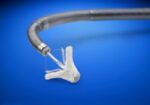Original title: Open Label, Randomized, Placebo-Controlled Evaluation of Intracoronary Adenosine or Nitroprusside Alter Thrombus Aspiration During Primary Percutaneous Coronary Intervention for the Prevention of Microvascular Obstruction in Acute Myocardial Infartion . The Reopen-AMI Study Reference: Giampaolo Niccoli, et al. J Am Coll Cardiol Intv 2013. Article in Press One of the challenges of PCI is to achieve the...
Hybrid revascularization, combining strengths in high-risk patients
Original title: One-Stop Hybrid Coronary Revascularization versus Coronary Artery Bypass Graft and Percutaneous Coronary Intervention for the Treatment of Multivessel Coronary Artery Disease: Three-Year Follow-up Results from A Single Institution. Reference: Liuzhong Shen et al. J Am Coll Cardiol Intv 2013. Article in press. Accepted Manuscript. A mammary bridge to anterior descending artery (LMCA) with a permeability >...
A real challenge: Primary PCI on an Unprotected Left Main Coronary Culprit Lesion
Original title: A Systematic Review and Meta-Analysis on Primary Percutaneous Coronary Intervention on an Unprotected Left Main Coronary Artery Culprit Lesion in the setting of Acute Myocardial Infarction Reference: Marije M. Vis et al. J Am Coll Cardiol Intv 2013;6:317–24 Acute myocardial infarction with a significantly compromised unprotected left main coronary artery culprit lesion is relatively rare (4%...
Bivalirudin reduces bleeding complications in carotid angioplasty
Original title: Hemorrhagic and ischemic outcomes after bivalirudin versus unfractionated heparin during carotid artery stenting: A propensity score analysis from the NCDR. Reference: Wayangankar SA et al. Circ Cardiovasc Interv. 2013;Epub ahead of print. Bivalirudin is a direct thrombin inhibitor that has shown similar efficacy with a better safety profile in the context of coronary angioplasty. However, its...
First results of bioabsorbable metal scaffolds DREAMS
Original title: Safety and performance of the drug-eluting absorbable metal scaffold (DREAMS) in patients with de-novo coronary lesions: 12 month results of the prospective, multicentre, first-in-man BIOSOLVE-I trial. Reference: Michael Haude et al. Lancet 2013; 381: 836–44. Bioabsorbable scaffolds could improve vasomotion, remodelling and facilitate new interventions, both percutaneous and surgical. This new bioabsorbable scaffold, different from the...
MitraClip® in real life
Original title: Acute outcomes after MitraClip® therapy in highly aged patients: results from the German TRAnscatheter Mitral valve Interventions (TRAMI) Registry. Reference: Wolfgang Schillinger et al. EuroIntervention 2013; 8-online publish-ahead-of-print April 2013. Recently, percutaneous repair of the mitral valve with MitraClip®, (Abbott Vascular, Santa Clara, CA, USA), has emerged as an option for patients with severe mitral regurgitation,...
5 Year Follow Up Outcome of Zotarolimus Eluting Stent
Original title: The “Final” 5-Year Follow-Up From the ENDEAVOR IV Trial Comparing a Zotarolimus-Eluting Stent With a Paclitaxel-Eluting Stent. ENDEAVOR IV Investigators Reference: Ajay J. Kirtane et al. J Am Coll Cardiol Intv 2013. Article in press. The ENDEAVOR IV was a randomized controlled study with a noninferiority design that compared the Endeavor zotarolimus eluting stent (Medtronic, Santa...
IVUS improves outcomes in long lesions with DES
Original title: Randomized Comparison of Clinical Outcomes between Intravascular Ultrasound and Angiography-Guided Drug-Eluting Stent Implantation for Long Coronary Artery Stenosis. Reference: Jung-Sun Kim et al. J Am Coll Cardiol Intv 2013. Article in press. Treating long lesions is difficult and the chance of instant thrombosis may be higher in these lesions. Coronary intravascular ultrasound (IVUS) can help in...
Revascularization could improve areas traditionally considered necrotic
Original title: Prevalence of Regional Myocardial Thinning and Relationship With Myocardial Scarring in Patients With Coronary Artery Disease. Reference: Dipan J. Shah et al. JAMA. 2013;309(9):909-918 Regional left ventricular (LV) wall thinning is believed to represent chronic myocardial infarction. In fact, the most recent guidelines, both European and American, have concluded that “Images that show regional myocardial thinning...
Complete revascularization in one procedure is more cost effective and as safe as in stages.
Original title: Staged Versus One-time Complete Revascularization With Percutaneous Coronary Intervention for Multivessel Coronary Artery Disease Patients Without ST-Elevation Myocardial Infarction. Reference: Edward L. Hannan et al. Circ Cardiovasc Interv 2013;6;12-20. There is evidence that in patients with multi-vessel disease affected by an acute coronary syndrome (ACS) with ST segment elevation, only the cause lesion should be treated...









